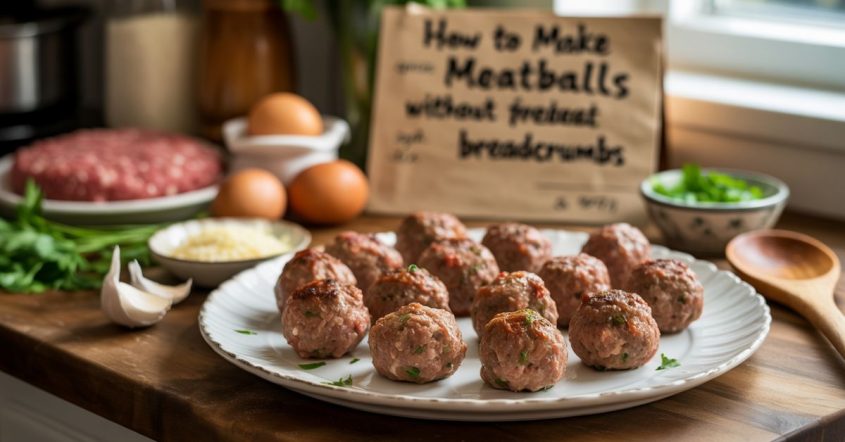Meatballs are a comfort food loved by many around the world. They’re juicy, flavorful, and incredibly versatile. Traditionally, breadcrumbs are an essential ingredient in meatball recipes. They help hold everything together and give the meatballs a nice, tender texture. But what if you can’t eat breadcrumbs? Maybe you’re avoiding gluten, following a low-carb diet, or you simply ran out of breadcrumbs. Don’t worry—you can still make mouthwatering meatballs without them!
In this guide, you’ll learn why breadcrumbs are used in the first place, what you can use instead, and how to make meatballs that are just as tasty (or even tastier) without them. We’ll also provide an easy-to-follow recipe and plenty of tips to help you succeed.
Understanding the Role of Breadcrumbs in Meatballs
Before we jump into substitutes, it’s important to understand what breadcrumbs actually do in a meatball recipe. Breadcrumbs serve three main purposes:
- Binding: Breadcrumbs absorb the juices from the meat and other ingredients, helping everything stick together.
- Texture: They soften the meatball’s texture, making them more tender and less dense.
- Moisture Retention: They hold in moisture, preventing the meatballs from drying out during cooking.
When breadcrumbs are removed, the meat mixture can become denser and more likely to fall apart. That’s why using suitable alternatives can serve the same function is important.
Effective Substitutes for Breadcrumbs
There are many great substitutes for breadcrumbs, and some might already be in your kitchen. Here are some of the best options:
1. Cheese as a Binder
Grated cheese, like Parmesan or mozzarella, works well as a binder and adds rich flavor. Parmesan especially helps to hold the meat together while giving it a salty, savory taste. Just be sure not to overdo it, or your meatballs may become too salty.
2. Flour Alternatives
Using regular flour or gluten-free flour can help bind the meat mixture. Almond flour and coconut flour are great low-carb options. These flours absorb some of the moisture and help the meatballs stay firm.
3. Eggs and Dairy
Eggs are one of the most common binders in meatball recipes, even when breadcrumbs are included. When you skip the breadcrumbs, eggs become even more important. You can also add a spoonful of ricotta cheese or plain Greek yogurt to give extra moisture and softness.
4. Vegetable Additions
Grated vegetables like onions, carrots, or zucchini can add moisture and texture to your meatballs. Be sure to squeeze out excess water before adding them to the mixture to avoid making it too wet.
5. Rice and Grains
Cooked rice, quinoa, or even mashed potatoes can serve as excellent binders. A famous example is porcupine meatballs, which use rice mixed into the meat to create a delicious texture.
These alternatives allow you to customize your meatballs to suit different diets and preferences, all while keeping them delicious and satisfying.
Step-by-Step Recipe: Classic Meatballs Without Breadcrumbs
Here’s a simple and delicious meatball recipe that skips the breadcrumbs entirely.
Ingredients:
- 1 pound ground beef (or a mix of beef and pork)
- 1 egg
- 1/4 cup grated Parmesan cheese
- 1/2 small onion, finely chopped or grated
- 1 garlic clove, minced
- 1 tablespoon chopped fresh parsley (optional)
- 1/4 teaspoon salt
- 1/4 teaspoon black pepper
- 1 tablespoon almond flour (optional, for extra binding)
Instructions:
- Preheat Oven: Set your oven to 400°F (200°C) and line a baking sheet with parchment paper.
- Mix Ingredients: In a large bowl, combine all ingredients. Use your hands to mix everything evenly but gently.
- Form Meatballs: Scoop out small portions and roll into balls about 1 to 1.5 inches wide. Place them on the prepared baking sheet.
- Bake: Bake the meatballs for 15-20 minutes, or until they are browned and fully cooked inside.
- Serve: Enjoy them with marinara sauce, pasta, or as a snack on their own.
Tips:
- Don’t overmix the meat; it can make the meatballs tough.
- If the mixture feels too wet, add a little more almond flour or grated cheese.
- Use a cookie scoop to keep all meatballs the same size.
Variations and Dietary Considerations
This basic recipe is easy to adapt. Here’s how you can change it up based on your dietary needs:
Gluten-Free Options
Use almond flour, coconut flour, or gluten-free oats instead of regular flour or breadcrumbs. These are naturally gluten-free and work well in most recipes.
Low-Carb/Keto-Friendly Recipes
Almond flour and cheese are perfect for keto diets. You can even add chopped bacon for extra fat and flavor.
Dairy-Free Alternatives
Skip the cheese and use dairy-free yogurt or mashed vegetables like sweet potatoes. Just make sure they’re not too watery.
Cultural Variations
- Swedish Meatballs: Use ground pork and beef, and season with allspice and nutmeg.
- Asian Meatballs: Add soy sauce, ginger, and green onions. Serve with a teriyaki glaze.
- Mediterranean Meatballs: Use lamb, garlic, and herbs like oregano and mint.
Serving Suggestions
Meatballs without breadcrumbs are just as versatile as traditional ones. Here are some great ways to enjoy them:
- With Sauce: Top with marinara, BBQ, or creamy sauces.
- Over Pasta: Classic spaghetti and meatballs still works!
- In Sandwiches: Make a meatball sub with melted cheese.
- On Rice or Quinoa: A healthier, gluten-free option.
- As an Appetizer: Serve with toothpicks and dipping sauce at parties.
- In Soup: Add them to vegetable or noodle soups.
Storage and Reheating Tips
If you make a big batch, you’ll want to store them properly:
Refrigeration:
- Place cooked meatballs in an airtight container.
- Store in the fridge for up to 4 days.
Freezing:
- Lay the cooked meatballs on a tray and freeze for 1 hour.
- Transfer to a freezer bag or container and keep for up to 3 months.
Reheating:
- Reheat in the microwave, oven, or simmer in sauce until hot.
- Avoid overcooking so they stay juicy.
Conclusion
You don’t need breadcrumbs to make delicious, juicy meatballs. With a few smart swaps like cheese, eggs, vegetables, or flour, you can create meatballs that are just as satisfying. This guide gives you everything you need to get started—from understanding the purpose of breadcrumbs to exploring creative variations. Whether you’re cooking for dietary reasons or just experimenting, making meatballs without breadcrumbs is easy, fun, and rewarding. Happy cooking!
















